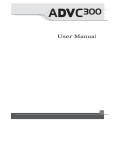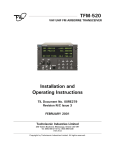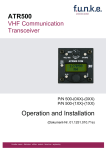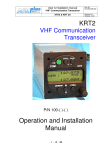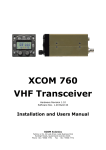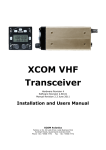Download BENDIXKing KY 96A Installation manual
Transcript
INSTALLATION MANUAL KY 196B VHF COMMUNICATIONS TRANSCEIVER MANUAL NUMBER 006--10570--0001 REVISION 1, JANUARY, 2000 WARNING Prior to export of this document, review for export license requirement is needed. COPYRIGHT NOTICE ! 2000 Honeywell International Inc. Reproduction of this publication or any portion thereof by any means without the express written permission of Honeywell International Inc. is prohibited. For further information contact the Manager, Technical Publications, Honeywell International Inc., One Technology Center, 23500 West 105th Street, Olathe, Kansas 66061. Telephone: (913) 782--0400 BENDIX/KING KY 196B VHF COMMUNICATIONS TRANSCEIVER SECTION I GENERAL INFORMATION Paragraph Page 1.1 INTRODUCTION 1--1 1.2 DESCRIPTION OF EQUIPMENT 1--1 1.3 TECHNICAL CHARACTERISTICS 1--1 1.4 UNITS AND ACCESSORIES SUPPLIED 1--4 1.5 ACCESSORIES REQUIRED, BUT NOT SUPPLIED 1--5 1.6 LICENSE REQUIREMENTS 1--5 1.7 INSTRUCTIONS FOR CONTINUED AIRWORTHINESS 1--6 SECTION II INSTALLATION 2.1 GENERAL INFORMATION 2--1 2.2 UNPACKING AND INSPECTING EQUIPMENT 2--1 2.3 EQUIPMENT INSTALLATION 2--1 2.3.1 AVIONICS COOLING REQUIREMENTS 2--1 2.3.2 MOUNTING RACK INSTALLATION 2--2 2.3.3 ANTENNA INSTALLATION 2--2 2.3.4 CABLE HARNESS AND CONNECTOR ASSEMBLY 2--2 2.3.5 KY 196B INSTALLATION 2--3 2.3.6 MOLEX TERMINAL INSTRUCTIONS 2--5 2.4 POST INSTALLATION CHECKS 2--7 SECTION III OPERATION 3.1 GENERAL INFORMATION 3--1 3.1.1 TURN ON 3--1 3.1.2 TRANSMIT INDICATOR 3--1 3.1.3 MODES OF OPERATION 3--1 3.1.4 REMOTE FREQUENCY TRANSFER 3--3 3.1.5 REMOTE CHANNEL INCREMENT 3--3 3.1.6 DIM SELECT 3--3 3.1.7 DISPLAY ADJUST MODE 3--3 10570I01.ZIPCDL Rev 1 January/2000 Page i BENDIX/KING KY 196B VHF COMMUNICATIONS TRANSCEIVER TSO APPENDIX ENVIRONMENTAL QUALIFICATION FORMS Drawing No. Page 004--02170--0082 . . . . . . . . . . . . . . . . . . . . . . . . . . . . . . . . . . . . . . . . . . . . TSO--1 LIST OF ILLUSTRATIONS Figure 2--1 MOLEX TERMINALS AND TOOLS . . . . . . . . . . . . . . . . . . . . . . . . 2--2 HAND CRIMPER . . . . . . . . . . . . . . . . . . . . . . . . . . . . . . . . . . . . . . . . 2--3 CRIMP JAWS . . . . . . . . . . . . . . . . . . . . . . . . . . . . . . . . . . . . . . . . . . . 2--4 TERMINAL INSERTION . . . . . . . . . . . . . . . . . . . . . . . . . . . . . . . . . . 2--5 HAND CRIMPER INSERTION . . . . . . . . . . . . . . . . . . . . . . . . . . . . 2--6 CRIMPING PRESSURE ADJUSTMENT . . . . . . . . . . . . . . . . . . . . 2--7 CONNECTOR ASSEMBLY . . . . . . . . . . . . . . . . . . . . . . . . . . . . . . . 2--8 OUTLINE AND MOUNTING DRAWING . . . . . . . . . . . . . . . . . . . . 2--9 INSTALLATION ASSEMBLY DRAWING . . . . . . . . . . . . . . . . . . . . 2--10 KY 196B INTERCONNECT . . . . . . . . . . . . . . . . . . . . . . . . . . . . . . 2--11 DUAL KY 196B INTERCONNECT DIAGRAM . . . . . . . . . . . . . . . 2--12 KY 196B INTERCONNECT WITH KA 25A . . . . . . . . . . . . . . . . . 2--13 KY 196B PIN FUNCTION AND LOCATION DIAGRAM . . . . . . . Page 2--4 2--5 2--5 2--6 2--6 2--7 2--9 2--11 2--13 2--15 2--17 2--19 2--23 3--1 KY 196B VHF COMMUNICATIONS TRANSCEIVER . . . . . . . . . 3--5 Page ii 10570I01.ZIPCDL Rev 1 January/2000 BENDIX/KING KY 196B VHF COMMUNICATIONS TRANSCEIVER SECTION I GENERAL INFORMATION 1.1 INTRODUCTION This manual contains information relative to the physical, mechanical, and electrical characteristics of the BENDIX/KING KY 196B VHF Communications Transceiver. Installation and operating procedures are also included. Information relative to the maintenance, alignment, and procurement of replacement parts may be found in the KY 196B Maintenance/Overhaul Manual. 1.2 DESCRIPTION OF EQUIPMENT The KY 196B VHF Comm Transceiver consists electrically of five sections: receiver, transmitter, synthesizer, display circuitry, and the microprocessor board. The KY 196B operates at 28VDC and features 16 Watts of transmitter power. The KY 196B is available with 8.33 KHz or 25KHz receiver selectivity, diffused display lenses, backlit bezel nomenclature, and operating ranges of 118.000 to 136.9916 MHz. See Paragraph 1.4 below for descriptions of specific flavors. The KY 196B has the capability of programming up to nine memory channel frequencies for later recall. Channel frequency information is stored in non -- volatile memory so the when the radio is turned off and then back on, channel information is retained. Both units also have the capability of remote transfer of Use and Standby frequencies, and remote recall of channel frequency information. 1.3 TECHNICAL CHARACTERISTICS SPECIFICATION CHARACTERISTIC TSO COMPLIANCE: Transmitter: KY 196B (flavors --0101, --0201) TSO C37c, DO--186 Class 3 TSO C37c, DO--186a Class 5 Receiver: KY 196B (flavors --0101, --0201) TSO C38c, DO--186 Classes C & D TSO C38c, DO--186a Class E ENVIRONMENTAL DATA: See TSO Appendix PHYSICAL DIMENSIONS: Height: 1.35 in (3.43 cm) Width: 6.312 in (16.032 cm) Depth (behind aircraft panel): 10.776 in (27.371 cm) WEIGHT: With rack 3.2 lbs (1.45 Kg), ¦0.2 lbs (0.09 Kg.) Without rack 3.0 lbs (1.36 Kg), ¦0.2 lbs (0.09 Kg.) MOUNTING: 10570I01.ZIPCDL Rev 1 January/2000 Panel mounted, no shock mounting required Page 1-1 BENDIX/KING KY 196B VHF COMMUNICATIONS TRANSCEIVER TEMPERATURE RANGE: --20°C to +55°C with short time operation at +70°C POWER REQUIREMENTS: KY 196B: 28VDC at 0.4A (Receive) 6.5A (Transmit) FREQUENCY RANGE: 118.000 MHz to 136.9916 MHz in 8.33 KHz mode. 118.000 MHz to 136.975 MHz in 25 KHz mode FREQUENCY STABILITY: 0.0005% from --20°C to +55°C DESIGN: All solid state, Printed circuit board and point to point wiring. FCC ID: ASYKY196B FCC EMISSION DESIGNATORS: 6K00A3E 6K00A9W TRANSMITTER POWER OUTPUT: KY 196B: 16 Watts minimum MODULATION: 70% modulation capability with 98% limiting. Less than 15% distortion at 70% modulation. SIDETONE OUTPUT: Adjustable up to 100mW into 500Ω headphones MICROPHONE: Standard carbon dynamic mic containing transistorized preamp. Must provide 100mVRMS into 100Ω load. HARMONIC CONTENT: Greater than 60dB down from carrier. HIGH TEMPERATURE PROTECTION: If the transmitter or modulator circuits become hot enough to potentially hurt any components in the transceiver, a protection circuit will automatically turn down the transmitter power consumption and output power to 4 Watts minimum. DUTY CYCLE: Page 1-2 1 minute on, 4 minutes off 10570I01.ZIPCDL Rev 1 January/2000 BENDIX/KING KY 196B VHF COMMUNICATIONS TRANSCEIVER RECEIVER RECEIVER SENSITIVITY: 2µV (hard) shall produce not less than 6dB S+N/N with 1KHz tone modulated 30% (with compressor disabled). RECEIVER SELECTIVITY: Class C, D (flavors --0101, --0201) 6dB bandwidth at not less than 8.0 KHz on each side. 40dB bandwidth with no more than 17.0 KHz on each side. 60dB bandwidth with no more than 22.0 KHz on each side. Class E (flavors --0101, --0201) 6 dB bandwidth at not less than 2.778 kHz on each side. 60 dB bandwidth at not more than 7.37 kHz on each side. RECEIVER OUTPUT: 100mW minimum into 500Ω minimum. AGC CHARACTERISTIC: From 10 µV to 100,000 µV audio output will not vary more than 3dB. SQUELCH: Automatic squelch (internally adjustable carrier--to--noise setting) with manual disable. SPURIOUS RESPONSES AND CROSS MODULATION PRODUCTS: INTERCOM INPUT: 10570I01.ZIPCDL Rev 1 January/2000 At least 80dB down. The mic is connected to the intercom input. The receiver is operational and mic audio appears at the audio output along with receive audio. 100mVRMS of mic audio into 100Ω is required for 100mW output. Page 1-3 BENDIX/KING KY 196B VHF COMMUNICATIONS TRANSCEIVER 1.4 UNITS AND ACCESSORIES SUPPLIED A. KY 196B VHF Comm Transceiver, PN 064--01084--XXXX, which is available in the following flavors: PN Receiver Selectivity LENS FREQUENCY RANGE 064--01084--0101 8.33 / 25 KHz Diffused 118.000 to 136.9916MHz 064--01084--0201 8.33 / 25 KHz N/A 118.000 to 136.9916MHz NOTE Some part numbers may not be currently available. Consult the current Honeywell International Inc. catalog or contact your Honeywell International Inc. representative for equipment availability. NOTE The 064--01084--0201 version has 5V lighting. Also, the bezel will be removed since this version is used in common bezel applications such as the CNI 5000. B. KY 196B Installation Kit, PN 050--02600--0000, which contains the following components: PN DESCRIPTION QTY 030--00101--0002 PANEL MOUNT PLUG 1.00 030--01094--0080 CONNECTOR KEYED 1.00 030--01107--0031 CONNECTOR TERM 31T 1.00 057--02193--0001 DECAL COMM 1 1.00 057--02193--0002 DECAL COMM 2 1.00 089--02013--0037 NUT HEX 6--32 1.00 089--02051--0024 NUT SPEED U 6--32 4.00 089--02191--0022 NUT HEX ESNA 6--32 1.00 089--02353--0001 NUT CLIP 6--32 6.00 089--05903--0007 SCR PHP 4--40X7/16 2.00 089--05907--0008 SCR PHP 6--32X1/2 1.00 089--06012--0008 SCR FHP 6--32X1/2 6.00 089--08094--0030 WSHR FLT STD .446 1.00 089--08168--0002 WASHER WAVE 1.00 090--00019--0007 RING RTNR .438 1.00 091--00072--0002 CABLE CLAMP 2 1.00 Page 1-4 10570I01.ZIPCDL Rev 1 January/2000 BENDIX/KING KY 196B VHF COMMUNICATIONS TRANSCEIVER 1.5 ACCESSORIES REQUIRED, BUT NOT SUPPLIED A. Communications antenna and cables. For Installations which must meet the German Cetecom antenna conducted radiation requirement, one of the following antenna must be used: Manufacturer Part Number Chelton 21--38--1RF/36 Dayton Granger VF10--108--2 Trivec--Avant Corp. 17--40--02W Trivec--Avant Corp. 18--50--01 B. Headphones: 500Ω nominal impedance. C. Microphone: Low impedance carbon or dynamic with transistorized preamp. D. For 13.75V operation of the KY 196B a 14 to 28V converter such as the KGS Electronics Model RB--125 or equivalent may be used. The RB--125 is available from BENDIX/KING under PN 068--01016--0003. 1.6 LICENSE REQUIREMENTS The transmitter, as installed in the aircraft, requires an Aircraft Radio Station License. This license is obtaining by filing FCC Form 404, Aircraft Radio Station License Application, which may be obtained from your local FCC Field Office. The KY 196B may be operated for up to 30 days without a station license after filing Form 404 while awaiting the receipt of the radio license if a copy of FCC Form 404 is kept in the aircraft. This equipment has been type accepted by the FCC and entered on their list of type accepted equipment as Honeywell International Inc. KY 196B, and must be identified as Honeywell International Inc. KY 196B on FCC Form 404. CAUTION THE VHF TRANSMITTER IN THIS EQUIPMENT IS GUARANTEED TO MEET FEDERAL COMMUNICATIONS COMMISSION ACCEPTANCE OVER THE OPERATING TEMPERATURE RANGE ONLY WHEN AN HONEYWELL INTERNATIONAL INC. CRYSTAL IS USED IN THE STABILIZED MASTER OSCILLATOR. USE OF OTHER THAN AN HONEYWELL INTERNATIONAL INC. CRYSTAL IS CONSIDERED AN UNAUTHORIZED MODIFICATION AND MAY VOID THE WARRANTY. 10570I01.ZIPCDL Rev 1 January/2000 Page 1-5 BENDIX/KING KY 196B VHF COMMUNICATIONS TRANSCEIVER The Federal Communications Commission requires that the operator of the transmitter of this equipment hold a Restricted Radio Telephone Operator Permit (FCC Form 753) or higher class license. A permit may be obtained by a US citizen from the nearest field office of the FCC; no examination is required. 1.7 INSTRUCTIONS FOR CONTINUED AIRWORTHINESS The instructions for continued airworthiness given in the TC or STC approvals for this product supplements or supercedes the instructions for continued airworthiness in this manual. Most Honeywell International Inc. products are designed and manufactured to allow ”on condition maintenance.” On condition maintenance is described as follows; There are no periodic service requirements necessary to maintain continued airworthiness. No maintenance is required until the equipment does not properly perform it’s intended function. When service is required, a complete performance test should be accomplished following any repair action. Consult the appropriate unit Maintenance/Overhaul Manual for complete performance test information. Page 1-6 10570I01.ZIPCDL Rev 1 January/2000 BENDIX/KING KY 196B VHF COMMUNICATIONS TRANSCEIVER SECTION II INSTALLATION 2.1 GENERAL INFORMATION This section contains suggestions and factors to consider before installing the KY 196B. Close adherence to these suggestions will assure more satisfactory performance from the equipment. 2.2 UNPACKING AND INSPECTING EQUIPMENT Unpack the equipment carefully and inspect each item for evidence of damage incurred during shipment. If a damage claim must be filed, save the shipping container and all packing materials to substantiate your claim. The claim should be filed with the transportation company as soon as possible. The shipping container and packing material should be saved in any case in the event that storage or reshipment of the equipment is necessary. 2.3 EQUIPMENT INSTALLATION The KY 196B installation will conform to standards designated by the customer, installing agency, and existing conditions as to the unit location and type of installation. However, the following suggestions should be considered before installing the KY 196B. The installing agency will supply and fabricate all external cables. The connectors required are supplied by Honeywell International Inc.. Interconnect diagrams are included in this manual as Figures 2--10 through 2--12. Refer to table below for compatible installations. Table 2--1 KY--Series Radio Installation compatibility Current Installation -- --> KY 96A KY 97A KY 196 KY 196A KY 197 KY 197A KY196B YES *1 *3 NO YES *2 YES NO NO *1 Display brightness controlled by dimmer bus not photocell. *2 Button/Bezel backlighting not operative. *3 If installation utilizes external audio amplifier. NOTE: 064--01084--0201 is not compatible with other KY 96A/196A/197A installations, due to the 5 volt panel lighting and Bezel difference. NOTE Use good quality stranded wire with at least 600V insulation that will not support a flame. 2.3.1 AVIONICS COOLING REQUIREMENTS FOR PANEL MOUNTED EQUIPMENT The most important contribution to improved reliability of avionics equipment is to limit the maximum operating temperature of each unit. While modern designs consume less total energy, the heat dissipated per unit volume (Watts/cubic inch) remains much the same due to contemporary high density packaging techniques. While each individual unit may or may not require forced air cooling, the combined heat generated by several units operating in 10570I01.ZIPCDL Rev 1 January/2000 Page 2-1 BENDIX/KING KY 196B VHF COMMUNICATIONS TRANSCEIVER a typical panel or rack can significantly degrade the reliability of the equipment if provisions for adequate cooling are not incorporated in the initial installation. 2.3.2 MOUNTING RACK INSTALLATION A. The KY 196B is mounted rigidly in the aircraft panel. Select a position in the panel that is not too close to any high external heat source. Remember to allow adequate space for installation of cables and connectors. Avoid sharp bends and placing the cables too near the aircraft control cables. B. When installing two or more panel mounted units in a stack, the mounting trays shall be spaced 0.050 inches (0.127 cm) apart. Current production mounting trays have 0.025 inch (0.064 cm) dimples built in to top and bottom and both sides so that the trays will automatically be spaced properly. C. Refer to Figure 2--8 for the KY 196B mounting dimensions. Mark and cut the mounting holes. D. Secure the mounting rack to the instrument panel per Figure 2--8. The rear mounting bosses should be attached to the airframe by means of support brackets. 2.3.3 ANTENNA INSTALLATION A conventional 50Ω vertically polarized comm antenna is required with the KY 196B. Vertical bent whip antennas are not recommended. Wideband comm antennas provide efficient operation over the comm band. Antennas should be installed per manufacturer’s recommendations. Additional recommendations are as follows: A. Mount antenna on a flat metal surface or install a ground plane at least 18 inches square. B. The antenna should be well removed from any projections and the engine(s) and propeller(s). Also, for satisfactory operation, the antenna isolation between a communications transmitter antenna and a nav receiver antenna, as well as between dual comm antennas, should be a minimum of 30dB. VHF antennas mounted on top and bottom have approximately 30dB isolation. A horizontally polarized nav antenna and a vertically polarized comm antenna will have practical values from 10 to 30dB. C. If both comm antennas must be top mounted or both bottom mounted, antenna isolation between comms may not be adequate to prevent reradiation. In single audio panel installations, reradiation can be prevented by use of the XMIT--REC interlock. In dual audio panel installations where simultaneous operation of both comms is desired, the XMIT--REC interlock is not recommended. 2.3.4 CABLE HARNESS AND CONNECTOR ASSEMBLY The KY 196B uses a special connector that mates directly with the printed circuit board inside the unit. Assembly of the connector is as follows: A. Contact Terminal Assembly using Molex Crimper (See Figure 2--2) 1. Strip each wire 5/32” for contact terminal, PN 030--01107--00XX. Note: The last two digits of the part number indicates the number of terminals required. 2. Place the conductor tab section of a contact terminal on the appropriate anvil of the hand crimping tool. Close the crimper until the terminal is held lightly in place. Page 2-2 10570I01.ZIPCDL Rev 1 January/2000 BENDIX/KING KY 196B VHF COMMUNICATIONS TRANSCEIVER 3. Insert the stripped conductor into the contact until the insulation is even with the side of the crimper facing the operator, the conductor hits the crimper’s wire stop, or the insulation contacts the crimpers step--jaw, depending on the type of crimp tool being used. 4. Squeeze the crimping tool’s handles until the crimp jaws are fully closed or until a sufficient crimp is obtained. With a step--jaw type crimper, the contact terminal will have been crimped to both the insulated and bare sections of the conductor. If single--jaw crimpers are being used, move the contact terminal/conductor assembly to locate the terminal’s insulation tabs on the anvil of the crimp tool. Crimp again until the jaws are fully closed or a sufficient crimp is obtained to the insulation. B. Contact Insertion into Molex Connector Housing After the contact terminals have been installed on the wiring harness, the contact terminals can be inserted into the proper location in the connector housing (PN 030--01094--0080). The terminal cannot be inserted upside down. Be sure to push the terminal all the way in until a click can be felt or heard. The self--locking feature can be tested by gently pulling on the wire. C. Location of Polarizing Key in Housing Prior to insertion of connector into rear of unit, check polarizing key position between contacts 8 and 9. Refer to Figure 2--9 to check correct position of polarizing key. D. Extraction of Contact from Molex Connector 1. Slip the flat narrow blade of a Molex HT--1884 contact ejector tool, PN 047--05099--0001, under the contact on the mating side of the connector. By turning the connector upside down one can see the blade slide into the stop. 2. When the ejector is slid into place, the retaining tab of the contact is raised, allowing the contact to be removed by pulling moderately on the lead. 3. Neither the contact or position is damaged by removing a contact; however, the contact should be visually checked before reinstalling to be certain that retaining tab ”A” extends as shown in Figure 2--1 for retention in connector. E. Coax Connector Refer to Figure 2--7 for instructions for mounting the right angle coaxial BNC connector to the coax cable. Install the connector into the mounting rack. 2.3.5 KY 196B INSTALLATION A. Looking at the top of the unit, make sure the front lobe of the hold--down device is in a vertical position. B. Slide the unit into the mounting rack until the front lobe touches the mounting rack. C. Insert a 3/32” Allen wrench through the hole in the front panel to engage the locking screw. Turn clockwise until the rear lobe engages the mounting rack. Continue turning until the unit is secure in the mounting rack. DO NOT OVERTIGHTEN. D. To remove the unit turn the locking screw counterclockwise, using a 3/32” Allen wrench, until the unit disengages from the mounting rack. Pull the unit out of the mounting rack by pulling on the indentations on each side of the unit’s bezel. 10570I01.ZIPCDL Rev 1 January/2000 Page 2-3 BENDIX/KING KY 196B VHF COMMUNICATIONS TRANSCEIVER CONDUCTOR CRIMP Figure 2--1 Molex Terminals and Tools Page 2-4 10570I01.ZIPCDL Rev 1 January/2000 BENDIX/KING KY 196B VHF COMMUNICATIONS TRANSCEIVER 2.3.6 MOLEX TERMINAL INSTRUCTIONS The Molex hand crimpers are available under P/N 071--06041--0000, or from Molex under P/N 6115. Holding the hand crimpers as shown, release the crimper’s ratchet pawl and open by squeezing tightly on the handles, and then releasing pressure. FIGURE 2--2 HAND CRIMPER Close crimpers until ratchet begins to engage. Then insert the terminal into the jaws from the back side. (See Figure 2--3 and 2--4) For 24 to 30 AWG wire, it will be necessary to start the crimp in jaw A and then complete it in jaw B. The terminal is in the correct position when the insulation tabs are flush with the outside face of the crimp jaws. JAW TERMINAL WIRE SIZE INSULATION RANGE A 030-01107-0030 18 TO 24 AWG .110 TO .055 B 030-01107-0030 24 TO 30AWG .055 TO .030 FIGURE 2--3 CRIMP JAWS 10570I01.ZIPCDL Rev 1 January/2000 Page 2-5 BENDIX/KING KY 196B VHF COMMUNICATIONS TRANSCEIVER FIGURE 2--4 TERMINAL INSERTION Once the terminal is in the correct position, close the jaws gently until the terminal is held loosely in place. Push the wire stop down so that it rests snugly behind the contact portion of the terminal. Strip the wire insulation back 1/8 inch and insert the wire through the insulation tabs into the conductor tabs until the insulation hits the conductor jaw face or until the conductor touches the wire stop. Squeeze the handles until the crimp jaws close and the ratchet releases. Straighten the terminal if necessary, then release the plier grips and remove the crimped terminal. FIGURE 2--5 HAND CRIMPER INSERTION If too much or too little pressure is needed to release the crimper’s ratchet pawl at the end of the crimp stroke, the ratchet can be easily adjusted. A spanner wrench provided with the tool can be used to loosen the lock nut, and rotate the keyed stud clockwise for increased pressure and counter clockwise for decreased pressure. Once the desired pressure has been set, the lock nut must be tightened again. Newer models may have a screwdriver adjustment. Page 2-6 10570I01.ZIPCDL Rev 1 January/2000 BENDIX/KING KY 196B VHF COMMUNICATIONS TRANSCEIVER FIGURE 2--6 CRIMPING PRESSURE ADJUSTMENT 2.4 POST INSTALLATION CHECKS An operational performance flight test is recommended after the installation is completed to insure satisfactory performance of the equipment in its normal environment. Check all aircraft control movements to be sure no electrical cables interfere with their operation. To check the communications transceiver, maintain an appropriate altitude and contact a ground station facility at a range of at least 50 nautical miles. Then contact a ground station close in. Pull the volume control out to defeat the automatic squelch feature and listen for any unusual electrical noise which would reduce the comm receiver sensitivity by increasing the squelch threshold. If possible, verify the communications capability on both the high and low end of the VHF comm band. NOTE As an added precaution before the flight, check the antenna. VSWR should be checked with an in--line type wattmeter inserted in the coaxial transmission line between the transceiver and the antenna. Any problem with the antenna installation will most likely be seen as a high reflected power. A VSWR of 3:1 will result in a 25% loss of power. The brightness of the display can be set for the most pleasing intensity by placing the unit in Dimmer Adjust mode during low light level conditions. See Paragraph 3.1 of this manual for Dimmer Adjust mode operating instructions. 10570I01.ZIPCDL Rev 1 January/2000 Page 2-7 BENDIX/KING KY 196B VHF COMMUNICATIONS TRANSCEIVER Page 2-8 10570I01.ZIPCDL Rev 1 January/2000 BENDIX/KING KY 196B VHF COMMUNICATIONS TRANSCEIVER NOTES: 1. WHEN SOLDERING, AVOID APPLYING EXCESS HEAT TO CONNECTOR BODY. HEAT SINK SPRING CONTACTS, AND CENTER CONDUCTOR INSULATOR. 2. ALTERNATE COAX RG--400 P/N 024--00051--0060 MAY BE USED. FIGURE 2--7 CONNECTOR (P/N 030--00101--0002) ASSEMBLY DWG. NO. 696--06328--0000 10570I01.ZIPCDL Rev 1 January/2000 Page 2-9 BENDIX/KING KY 196B VHF COMMUNICATIONS TRANSCEIVER NOTES: INCHES 1. DIMENSIONS ARE IN [MM] . Notes Continued: 2. WEIGHT: WITH RACK 3.2 LBS [1.45KG] ± 0.2LBS [0.09KG] WITHOUT RACK 3.0 LBS [1.36KG] ±0.2LBS [0.09KG] +0.10 / --.000 3. TOLERANCES FOR PANEL CUTOUTS: [+2.5 / --0] 4. WHEN INSTALLING TWO OR MORE PANEL MOUNTED UNITS IN A STACK, THE MOUNTING TRAYS SHALL BE SPACED .050 INCHES [1.27MM] APART. NEWER STYLE MOUNTING TRAYS HAVE .025 [.63] DIMPLES BUILT IN, TOP AND BOTTOM, BOTH SIDES, TO ENSURE PROPER SPACING. FIGURE 2--8 OUTLINE AND MOUNTING DRAWING DWG. NO. 064--01084--90, REV. A 10570I01.ZIPCDL Rev 1 January/2000 Page 2-11 5. TO DETERMINE STACK HEIGHT, USE THE HEIGHT DIMENSION FOR A FRONT AIRCRAFT PANEL MOUNT. 6. KY196B (064--01084--0101) ILLUSTRATED. ALL DIMENSIONS BETWEEN VARIOUS FLAVORS ARE IDENTICAL UNLESS OTHERWISE NOTED. ALL KNOBS AND CONTROL LOCATIONS/FUNCTIONS ARE IDENTICAL BETWEEN VARIOUS FLAVORS. 7. INSTALLATION INFORMATION FOR KY 196B 064--02084--0201 IS CONTAINED IN CNI5000 INSTALLATION MANUAL. 8. DIMENSIONS (EXCEPT PANEL CUTOUT OR MOUNTING USE DIMENSIONS) BENDIX/KING KY 196B VHF COMMUNICATIONS TRANSCEIVER FIGURE 2--9 INSTALLATION ASSEMBLY DRAWING DWG. NO. 155--05690--0000, REV. 4 10570I01.ZIPCDL Rev 1 January/2000 Page 2-13 BENDIX/KING KY 196B VHF COMMUNICATIONS TRANSCEIVER FIGURE 2--10 KY 196B INTERCONNECT DWG. NO.064--01084--92, REV. B 10570I01.ZIPCDL Rev 1 January/2000 Page 2-15 BENDIX/KING KY 196B VHF COMMUNICATIONS TRANSCEIVER FIGURE 2--11 DUAL KY 196B INTERCONNECT DIAGRAM DWG. NO. 064--01084--91 Rev A 10570I01.ZIPCDL Rev 1 January/2000 Page 2-17 BENDIX/KING KY 196B VHF COMMUNICATIONS TRANSCEIVER FIGURE 2--12 KY 196B INTERCONNECT WITH KA 25A DWG. NO. 064--01084--93 Rev A (Page 1 of 2) 10570I01.ZIPCDL Rev 1 January/2000 Page 2-19 BENDIX/KING KY 196B VHF COMMUNICATIONS TRANSCEIVER FIGURE 2--12 KY 196B INTERCONNECT WITH KA 25A DWG. NO. 064--01084--93 Rev A (Page 2 of 2) 10570I01.ZIPCDL Rev 1 January/2000 Page 2-21 BENDIX/KING KY 196B VHF COMMUNICATIONS TRANSCEIVER FIGURE 2--13 KY 196B PIN FUNCTION AND LOCATION DIAGRAM 10570I01.ZIPCDL Rev 1 January/2000 Page 2-23 BENDIX/KING KY 196B VHF COMMUNICATIONS TRANSCEIVER Page 2-24 10570I01.ZIPCDL Rev 1 January/2000 BENDIX/KING KY 196B VHF COMMUNICATIONS TRANSCEIVER SECTION III OPERATION 3.1 GENERAL INFORMATION For a detailed description of the operating controls of the KY 196B refer to the ’Silver Crown +’ pilots guide (P/N 006--18110--0000) or the aircraft’s flight manual supplement. Control layout is shown in Figure 3--1. 3.1.1 TURN ON To turn on the radio rotate the Volume (VOL) knob clockwise from the OFF position. When power is activated the Use and Standby (STBY) windows will display the frequencies and/or mode stored in the non--volatile memory before power down. After activating power, pull the VOL knob out to override the automatic squelch and rotate the VOL knob to the desired audio level. Push the VOL knob back in to activate the automatic squelch. CAUTION THE KY 196B SHOULD BE TURNED ON ONLY AFTER ENGINE STARTUP. THIS IS A SIMPLE PRECAUTION WHICH HELPS PROTECT THE SOLID STATE CIRCUITRY AND EXTENDS THE OPERATING LIFE OF YOUR AVIONICS EQUIPMENT. 3.1.2 TRANSMIT INDICATOR During Comm transmissions, a T will appear between the USE and STBY windows to indicate that the Mic has been keyed. 3.1.3 MODES OF OPERATION A. Frequency Mode Frequency selection is accomplished in the Standby Entry mode by changing the frequency display in the STBY window of the display with the tuning knobs, and then transferring the selected frequency into the USE window by pressing the Transfer button. The larger tuning knob will increment or decrement the MHz portion of the display in 1MHz steps with rollover at each band edge (118 MHz or 136 MHz). the smaller tuning knob will increment or decrement the KHz portion of the display in 25 KHz steps with the knob pushed in or will tune both the 8.33 KHz and 25 KHz channels with the knob pulled out. While in the Standby Entry mode, the transceiver remains tuned to the frequency displayed in the USE window at all times. B. Channel Mode Momentarily pressing the Channel (CHAN) button while in the Frequency mode puts the radio in the Channel mode. The last active frequency remains tuned and displayed in the USE window. The last used channel number is displayed in the channel digit unless no channels have been programmed, in which case the radio defaults to Channel 1 and dashes are displayed in the STBY window. Turning either tuning knob changes the channel number and corresponding frequency in the STBY window. The channels will only increment and decrement to channels that have been programmed. If there has been no activity for five seconds the radio will return to Frequency mode and the channel frequency is placed in the STBY window. Pressing the CHAN button before the 10570I01.ZIPCDL Rev 1 January/2000 Page 3-1 BENDIX/KING KY 196B VHF COMMUNICATIONS TRANSCEIVER five second delay is completed will return the radio to the Frequency mode and the status of the Frequency mode prior to entering Channel mode remains the same. When in Channel mode, pressing the Transfer button will return the radio to Frequency mode. The channel frequency will become the new USE frequency and the last USE frequency will become the new STBY frequency. If the radio was in Direct Tune mode (See Paragraph 3.1.3.E below) prior to entering Channel mode, pressing the Transfer button or allowing the radio to time out will bring it back to Standby Entry. C. Program Mode The Program mode is entered by pressing and holding the CHAN button for longer than two seconds. The last active frequency remains tuned and displayed in the USE window. The last used channel number is displayed when Program mode is entered. The channel number flashes and turning either tuning knob changes the channel number. Pressing the Transfer button will cause the frequency associated with that channel to flash. The tuning knobs then work as in the Frequency mode, except that between the rollover points (118.XXX and 136.XXX) dashes are displayed. These dashes are used to de--program channels, and to display a channel that is unprogrammed. When the channel frequency is flashing, pressing the Transfer button will cause the frequency to stop flashing and the channel number to start flashing at which time a new channel may be selected for programming. D. Program Secure Mode Program Secure mode is used to secure or lock the frequency that is assigned to a channel so that the frequency assigned to that channel cannot be changed. All channels or individual channels can be Program Secured. The following list of operations is given to Program Secure or Un--Program Secure a channel: To Program Secure a Channel: 1. Hold the CHAN button in for more than 2 seconds (Program mode). 2. Momentarily press the Transfer button (flashing frequency). 3. Change channel frequency to desired Program Secured frequency. 4. Ground the Program Secure pin (TP 501). 5. Momentarily press the Transfer button (Flashing channel number). 6. Unground the Program Secure pin. To Un--Program Secure a Channel: 1. Hold the CHAN button in for more than 2 seconds (Program mode). 2. Ground the Program Secure pin (TP 501). 3. Momentarily press the Transfer button (flashing frequency). 4. Unground the Program Secure pin. 5. Momentarily press the Transfer button (Flashing channel number) E. Direct Tune Mode The Direct Tune mode is entered from the Standby Frequency Entry mode or Channel mode by pushing the Transfer button for longer than 2 seconds. The tuning knobs operate as in Standby Frequency Entry, but will change the USE frequency, rather than the STBY frequency. The radio will be tuned to the Active frequency. Page 3-2 10570I01.ZIPCDL Rev 1 January/2000 BENDIX/KING KY 196B VHF COMMUNICATIONS TRANSCEIVER Momentarily pushing the Transfer button returns the radio to Standby Frequency Entry. The Standby frequency prior to Active Entry mode remains unchanged. 3.1.4 REMOTE FREQUENCY TRANSFER The Remote Frequency Transfer button operates identically to the front panel Transfer button with the exception that holding the Remote Transfer button for two seconds does not place the radio in the Active Entry mode. 3.1.5 REMOTE CHANNEL INCREMENT Pressing the Remote Channel button will cause the system to enter the Channel mode of operation and will increment the channel from the previous channel number used. 3.1.6 DIM SELECT DIM SELECT LINE STATUS DISPLAY STATUS KY 196B +28VDC MAX BRIGHT (Pin A) OPEN FOLLOW PHOTOCELL GND DIMMER BUS 3.1.7 DISPLAY ADJUST MODE Press and hold the Channel button, when the unit enters program mode, press and hold the transfer button for more than 2 seconds so that DA 1 replaces the frequency in the USE window. The unit is now in display adjust mode, refer to the table below for a description of the 3 DA modes and ranges of operation. The increment and decrement knobs are used to set the proper value in the STANDBY window. Momentarily pressing the CHAN button increments the unit thru the 3 display adjust modes (DA 1 Thru DA 3). Press the transfer button to exit display adjust mode. RANGE DESCRIPTION DA 1 1 to 8 Display brightness (1=fast, 8=slow) DA 2 0 to 64 Response to dimmer photocell (0=dim, 64=bright) DA 3 0 to 255 Display age compensation for brightness (0=dim, 255=bright) MODE 10570I01.ZIPCDL Rev 1 January/2000 Page 3-3 BENDIX/KING KY 196B VHF COMMUNICATIONS TRANSCEIVER Page 3-4 10570I01.ZIPCDL Rev 1 January/2000 BENDIX/KING KY 196B VHF COMMUNICATIONS TRANSCEIVER ACTIVE TRANSMIT STANDBY CHANNEL CONCENTRIC FREQ INDICATOR FREQ NUMBER TUNING KNOBS (USE) TRANSFER CHANNEL BUTTON BUTTON ON/OFF VOL, SQUELCH CONTROL P/N: 064--01084--0101 NOTE: All knob and control locations/functions are identical between various flavors. No Faceplate on --0201 Flavor (CNI 5000 version). FIGURE 3--1 KY 196B VHF COMMUNICATIONS TRANSCEIVERS 10570I01.ZIPCDL Rev 1 January/2000 Page 3-5 BENDIX/KING KY 196B VHF COMMUNICATIONS TRANSCEIVER Page 3-6 10570I01.ZIPCDL Rev 1 January/2000 BENDIX/KING KY 196B VHF COMMUNICATIONS TRANSCEIVER TSO APPENDIX RTCA DO--160B ENVIRONMENTAL QUALIFICATION FORMS 10570I01.ZIPCDL Rev 1 January/2000 Page i BENDIX/KING KY 196B VHF COMMUNICATIONS TRANSCEIVER Page ii 10570I01.ZIPCDL Rev 1 January/2000 10570I01.ZIPCDL Rev 1 January/2000 Page TSO-1 Page TSO-2 10570I01.ZIPCDL Rev 1 January/2000 10570I01.ZIPCDL Rev 1 January/2000 Page TSO-3 This page is reserved Page TSO-4 10570I01.ZIPCDL Rev 1 January/2000










































